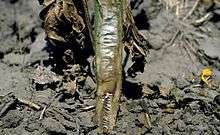Verticillium
| Verticillium | |
|---|---|
 | |
| Verticillium theobromae culture | |
| Scientific classification | |
| Kingdom: | Fungi |
| Division: | Ascomycota (Anamorphic Hypocreales) |
| Class: | Incertae sedis |
| Family: | Plectosphaerellaceae |
| Genus: | Verticillium Nees (1816) |
| Type species | |
| Verticillium tenerum Nees (1913) | |
| Species | |
|
See text | |
Verticillium is a genus of fungi in the division Ascomycota, and are an anamorphic form of the family Plectosphaerellaceae. The genus used to include diverse groups comprising saprobes and parasites of higher plants, insects, nematodes, mollusc eggs, and other fungi, thus the genus used to have a wide-ranging group of taxa characterised by simple but ill-defined characters. The genus, currently thought to contain 51 species,[1] may be broadly divided into three ecologically based groups - mycopathogens, entomopathogens,[2] and plant pathogens and related saprotrophs.[3] However, the genus has undergone recent revision into which most entomopathogenic and mycopathogenic isolates fall into a new group called Lecanicillium. The genus now includes the plant-pathogenic species V. dahliae, V. longisporum, V. albo-atrum, V. nubilum, and V. tricorpus.
The better-known species of Verticillium are V. dahliae, V. albo-atrum and V. longisporum, which cause wilt diseases called verticillium wilts in more than 400 eudicot plant species.
Selected species

- Verticillium dahliae Kleb.

- Verticillium albo-atrum Reinke & Berthold - causes verticillium wilt or maple wilt. First identified from potatoes in Germany in 1870, this species attacks over 300 different cultivated plants and can persist as a saprotrophic soil organism for more than 15 years. When infecting ornamental trees such as maples, elms, aspen, ash, beech, catalpa, oak, and others, the first symptoms are midsummer wilting on one side of a tree or branch. The sapwood has greenish or brownish streaks, and the infection can take a few years to progress to the rest of the tree or move rapidly. The fungi universally move up the xylem vessels. In fruit trees, the infection is known as black heart, and is common in apricots and sometimes affects almond, peach, plum, and avocado trees. This fungus also affects herbaceous ornamentals and vegetables such as chrysanthemums, mints, Lychnis spp., tomatoes, eggplants, okra, and rhubarb, causing wilting and death. Identification can be made by looking for one-celled conidia, hyaline round to ellipsoid which are formed at the tips of whorled branches. They are easily separated from the tips.
- Nematode pathogens, previously in Verticillium, have now been placed in the new genus Pochonia.
- All insect pathogens have been placed in the new genus Lecanicillium.[4] An approved name of Verticillium lecanii (Zimmerman) Viegas is now Lecanicillium lecanii although isolates may belong to: L. attenuatum, L. longisporum, L. muscarium, or L. nodulosum.
References
Further reading
- Barbara, D.J. & Clewes, E. (2003). "Plant pathogenic Verticillium species: how many of them are there?" Molecular Plant Pathology 4(4).297-305. Blackwell Publishing.
- Phillips, D. H. & Burdekin, D. A. (1992). Diseases of Forest and Ornamental Trees. Macmillan. ISBN 0-333-49493-8.
- Zare, R. and Gams, W. (2001). A revision of Verticillium sect. Prostrata. III. Generic classification. Nova Hedwigia. 72. 329-337.
External links
- Verticillium in Index Fungorum
- Fact sheet from Ohio State University Extension on verticillium and fusarium